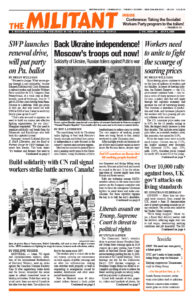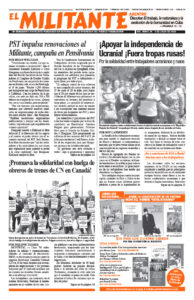“Compared to last year, government control this year was even stronger,” Daniel Chan wrote the Militant from Hong Kong June 15. He was referring to the large police operation blocking protesters there trying to hold a vigil to mark the June 4 anniversary of the Tiananmen Square massacre by China’s Stalinist rulers 33 years ago. Six were arrested as hundreds of people with candles converged on the police-barricaded Victoria Park.
The annual vigil commemorates the thousands killed and many more imprisoned or forced into exile when Beijing crushed their protests for political rights in 1989. A large encampment in the square, supported by millions of working people, was violently dispersed by the army with tanks and machine guns.
The Beijing regime called the challenge to its repressive rule “counterrevolutionary turmoil.” Ever since, it has tried to erase the memory of this slaughter.
Beijing’s censors rapidly removed an online video posted that day for a well-known brand of ice cream cake. It was decorated with cookies and a chocolate stick so it “looked like a tank.” This “made people recall the famous photo of a protester standing in front of a tank during the June 4 massacre,” Chan said.
“The Chinese and Hong Kong governments, in their attempts to stop people from remembering June 4, actually remind people not to forget the massacre,” Chan noted.
Anniversary vigils were held in over 20 cities around the world, from New York to London and from Sydney to Ulaanbaatar, Mongolia, which borders China. Hundreds protested in Taiwan, the self-governing island 500 miles to the east of Hong Kong. Beijing claims Taiwan as part of its territory and has increasingly threatened to invade.
Under the direct intervention of Beijing over the past couple of years, Hong Kong authorities have clamped down, outlawing street protests, jailing political opponents and forcing critical media outlets to close. To smother further protests Beijing imposed a sweeping national security law on Hong Kong. It criminalized protest actions by branding them as secession, subversion, terrorism or collusion with foreign forces, with penalties up to life imprisonment.
During the December student break, University of Hong Kong authorities removed a large blood-orange memorial sculpture to the victims of the Tiananmen carnage. The Pillar of Shame, depicting human torsos twisted together in anguish, had been there since 1998. Within days other universities in the city removed similar artwork.
Jens Galschiot, the Danish artist who created the monument, said now it also symbolizes Hong Kong’s eroding freedoms. The sculptor created a full-scale replica for display around the world, including in Taiwan.
A 30-year-old woman, who gave her name as Lau, told the Wall Street Journal she attended Hong Kong’s annual vigil every year and had set out to do so again. This time police stopped and searched her on her way to the park.
“They think even small sparks could start a prairie fire,” she said.

